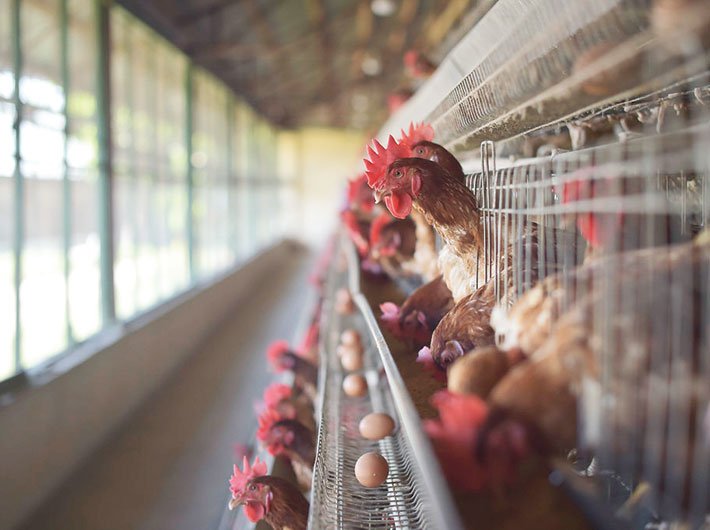Anti-microbial resistance (AMR) will create hard-to-treat bugs that will kill 10 mn people per year globally by 2050, more than cancer and diabetes. In India much of that resistance will spread from the antibiotic-laden meat we eat
It’s a Friday morning at a poultry warehouse in Gazipur, Delhi, not far from its infamous mountain of garbage. Kites and vultures roost on pylons and hover in the thermals over the swollen landfill. As dealers ready for the weekend peaking of sales, suppliers are delivering broilers by the hundreds. Feathers float about the wire cages as the tight-packed birds cluck and twitter, jostle about and flutter their wings. The air reeks with the ammonia stench of chicken poop. But the dealers and suppliers aren’t worried the one and a half lakh birds cooped together will sicken. For in the 40-odd days from hatching to slaughter, besides being vaccinated, chicken in poultry farms across India are dosed heavily with antibiotics.
This is dangerous to humans. Antimicrobial resistance (AMR) – the evolution of resistance to antibiotics in microbes, mostly through exposure to dosages that won’t kill them off – has become a global public health problem. When humans eat antibiotic-laden meat, bacteria in their body acquire resistance through exposure to minuscule amounts of the medication. This endangers individuals and populations: in individuals, antibiotics may not work when they take them to cure a disease; in populations, AMR spreads with the spreading and further evolution of the bacteria.
Blind to the problem
- A national action plan for anti-microbial resistance (NAP-AMR) was formulated in April 2017. It only makes a passing mention of AMR spreading through use of antibiotics in meat production
- Though food standards have regulations for use of medication and chemicals in seafood, there are none whatsoever for antimicrobials in cattle, chicken, pigs
- Farmers are free to buy growth promoters, which come with no information about dosage or ingredients. Many of them use antibiotics without veterinary supervision
- The department of animal husbandry, dairying and fisheries can report on the misuse of antibiotics but has no role in checking it or in policy making
- There is no monitoring of antibiotics released into the environment from water and other waste generated in poultry farms, animal husbandry, aquaculture
“There is great risk to human life when AMR builds through consumption of antibiotic-laden meat. Besides urinary tract infections, tuberculosis and pneumonia, even typhoid is becoming impossible to treat because no antibiotic works any more,” says Dr Chand Wattal, senior consultant and chairman of the clinical microbiology department at Sir Ganga Ram Hospital, Delhi. “Typhoid patients are now directly put on IV drips. Basic surgeries too are becoming tough to carry out.”
The connection is strong: most antibiotics used in poultry farming are also prescribed to humans. Chicken are given colistin, quinolones, carbapenems, ciprofloxacin and tetracyclins. These are also used to treat infections in humans. “Except for a very few of the antibiotics used for animals – such as flavomycin and salinomycin – they are all used for treating humans. The risk of creating resistance is huge,” says Dr Chandra M Gulhati, editor of the Monthly Index of Medical Specialities. Colistin and carbapenems, for instance, are largely used against multi-drug resistant (MDR) infections. So AMR spread through meat-eating robs humans of very potent, last-hope drugs. Dr Gulhati warns that what has happened with tuberculosis may happen with many other diseases: the world over, TB kills more than 1.5 million annually because extremely resistant variants are making treatment impossible.
The AMR danger from consumption of meat can be gauged from the fact that India is the fourth largest user of antibiotics for veterinary use: in 2010, it was 1,895 tonnes, or about three percent of the 63,151 tonnes used globally. China may have banned the use of colistin in animals, but it continues to be its biggest exporter to India. Quinolones have been banned or restricted for use in animals in the US and European Union but the Centre for Disease Dynamics, Economics and Policy (CDDEP), an American think-tank, projects a 243 percent increase in quinolone usage worldwide by 2030. Most of this will be in developing countries like India.
Colistins and quinolones pose a special threat, for they are non-biodegradable, which means they pass on into the environment and spread AMR through water. According to CDDEP, some of the highest levels of quinolone residues have been found in lakes and wells near waste-water processing units in Hyderabad. Not surprising, since Andhra Pradesh is a major centre of poultry farming. Naturally, AMR will spread further through those who use the water.
As meat consumption shoots up in India, the danger of AMR from animal sources is bound to increase. The National Sample Survey Office (NSSO) says that from 2004 to 2011, per capita monthly consumption of meat doubled from 0.13 kg to 0.27 kg in rural areas and from 0.22 kg to 0.39 kg in urban areas. More than 65 percent of India’s population is below 35, and its middle class numbers more than 600 million. The young and the middle class are open to stepping past caste restrictions on meat eating, and a growing cosmopolitanism in cities and small towns is encouraging the trend. Mass produced meat is cheaper, so more people are taking to it. Since it involves massive dosing with antibiotics and other medication, AMR can only worsen – unless restrictions are brought in.
About practices at poultry farms and meat farming centres, Dr Rajeshwari Sinha, a deputy programme manager for food safety and toxins at Centre for Science and Environment (CSE), says during its National Conclave on Food, “Withdrawal periods – the time animals are supposed to be left alone without medication before sale for consumption – are not followed.” What’s worse, chicken feed already contains antibiotics, but poultry farmers dose their stock with more, relying on advice from successful farmers rather than vets. Even meat labelled antibiotic-free is suspect, says Dr Gulhati. “Claims are only for publicity and promoting sales, and far, far away from facts,” he says.
In India, indiscriminate use by doctors and over-the-counter availability of antibiotics have already robbed them of effectiveness. Dr Isabel Frost, a fellow at CDDEP, Delhi, says the two most common resistant bacteria (extended spectrum beta-lactamase producers and methicillin-resistant staphylococcus aureus) alone cause more than 58,000 adult deaths annually in India. The figure for babies is 56,000. Adding to the problem is the spread of AMR from meat and poultry.
But the authorities are only just waking up to the AMR problem from careless prescription, incomplete drug regimens and self-medication. Leave alone implementation, even policies to combat AMR have only just taken shape. “Though a national action plan for AMR, endorsed by the environment ministry, was formulated in April 2017, it hasn’t been operationalised. AMR is still not being seen as a proper problem or disease,” says Dr Sunil Gupta, additional director at the National Centre for Disease Control, Delhi. Monitoring, too, is a herculean task. As Dr Gulhati puts it, “In western countries, it is possible to monitor and control use of antibiotics, but in India it’s a different story. In the US, more than 10,000 people are employed by the Food and Drug Administration (FDA), and in the UK, there are more than 1,200. And how many in India, which has a much bigger problem and a vast countryside? Hardly 400!”
In short, policymakers and public health authorities have not even started considering the spread of AMR from poultry and meat farming. A CDDEP report says the true extent of the spread of AMR from meat animals in India hasn’t been scoped, but mentions a telling fact: only one company produces benzathine penicillin for human use, whereas six make it for veterinary use. “It’s clear,” says Dr Frost, “that the use of antibiotics in animal rearing is contributing to the emergence and spread of highly resistant disease-causing bacteria.”
There are dangerous portents. Globally, and for countries like India in particular, AMR can have serious consequences. Lord Jim O’Neill, who chaired a much-quoted British report on AMR in 2014, calls it “a looming threat to our prosperity and sustained economic development in all parts of the world”. The O’Neill team’s ‘Review on Antimicrobial Resistance’ estimated the global loss of lives to AMR in 2014 at seven lakh annually. But by 2050, it is projected to balloon 14 times to 10 million, more than half of them (4.7 million) in Asia. This will make AMR the single largest global cause of deaths, at one death every three seconds, leaving cancer, cholera, diabetes and diarrhoeal diseases way behind. In terms of GDP loss, this would cost the world $100 trillion, five times the current GDP of the US. The world, especially highly populated developing countries like India, can ill-afford these costs.
In a roundabout way, the vultures hovering over the garbage heap in Gazipur tie up with the problem of AMR from meat animals. Through the 1990s and early 2000s, the vulture population in India had declined drastically. They were being poisoned by diclophenac, an anti-inflammatory drug given to cattle whose carcasses they were feeding on. It was only after India, Nepal and other countries banned the veterinary use of the drug that the vulture numbers started rising again.
That should serve as a cautionary tale. For the rampant use of antibiotics in meat animals leaves humans who eat them defenceless against attacks by highly resistant microbes. “AMR is forcing doctors to turn to more potent drugs as disease-causing organisms are growing resistant and more virulent,” says Dr Anuj Sharma, technical officer for AMR at the World Health Organisation. “This also delays treatment because doctors are alerted to AMR only after initial treatments fail.”
The O’Neill report warns of the return of a “dark age of medicine”. The World Health Organisation has since 2014 been prophesying a “pre-antibiotic era” and identifying the irrational use of antibiotics as a major cause.
We live in the shadow of vultures.
anushka@governancenow.com
(This article appears in the June 15, 2019 edition)

